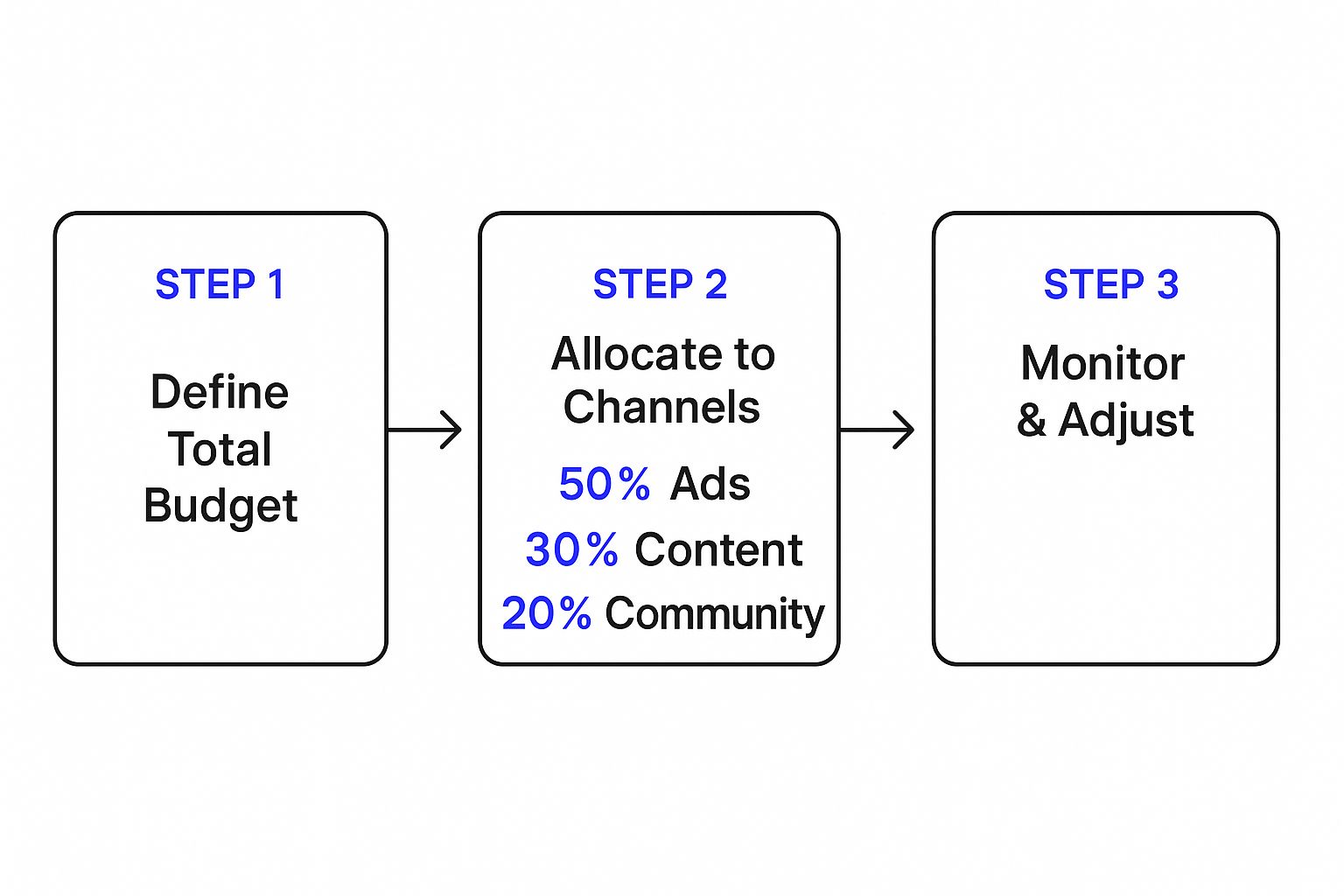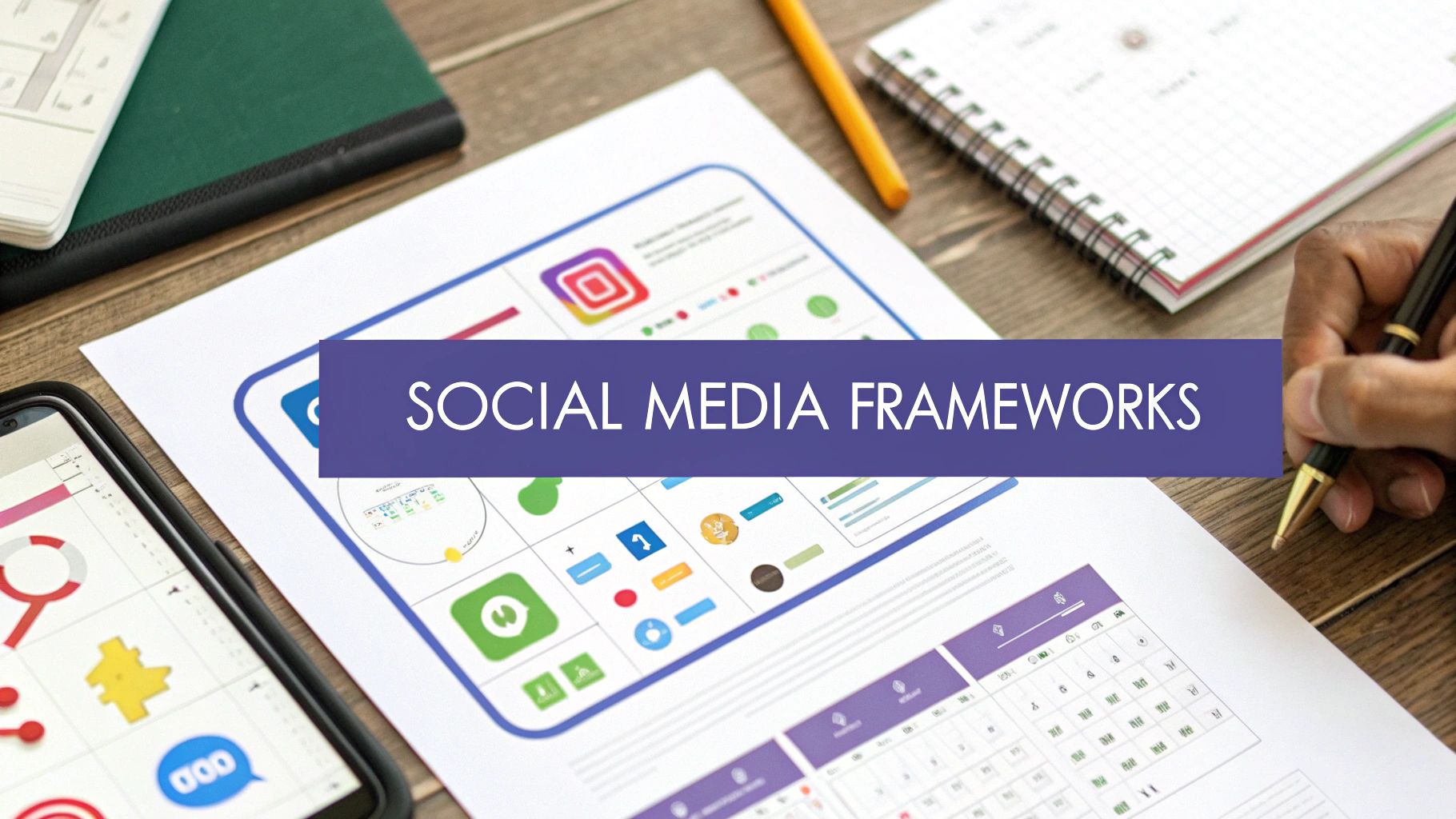Diving into social media without a clear strategy is a common mistake. It feels a lot like sailing without a compass—sure, you're moving, but you have no idea if you're heading toward your destination. A social media marketing plan template is that compass. It gives you the structure needed to turn random activity into a focused strategy that actually grows your business. It's your blueprint for success.
Building Your Strategic Foundation
Before you even think about scheduling your first post or picking out a stock photo, you have to lay the groundwork. I've seen countless businesses fizzle out on social media, not because their content was bad, but because their efforts weren't tied to any real business objective. A plan is what separates just doing social media from succeeding with it.
It all starts with a quick look in the mirror. A simple social media audit helps you see what's already working, what’s falling flat, and where your biggest opportunities are hiding. This isn't some deep, month-long analysis. Think of it as a quick snapshot to establish your starting line.
Defining Your Business Objectives First
The most critical part of your social media marketing plan template isn't the content calendar—it's the section where you outline your business goals. Seriously, why are you even on social media?
Your goals can't be vague; they need to be specific and directly connected to your company's bottom line. Here are a few examples of what that looks like in practice:
- Increasing Brand Awareness: Maybe you want to reach a whole new demographic or just become more visible in your current market.
- Driving Website Traffic: The goal here is to funnel qualified visitors from social platforms straight to your blog or product pages.
- Generating Leads: Using social media as a tool to capture contact info from potential customers.
- Building a Community: This is about creating a tribe of loyal followers who genuinely engage with your brand and each other.
The real purpose of your social media plan is to translate what your business needs into concrete actions online. Without that link, every post is just a shot in the dark.
To give you a sense of the scale we're talking about, there are an estimated 5.42 billion social media users across the globe, and the average person uses almost seven different platforms every month. This means a one-size-fits-all approach is doomed to fail. Your strategy has to be sharp enough to connect with the right people on the right channels.
The image below gives you a peek at how a well-structured plan starts, grounding your entire strategy in clear, actionable steps from the get-go.

As you can see, a solid plan connects your high-level business objectives to specific social media goals, ensuring every single action has a purpose. To get a better handle on these concepts, you can explore further insights and resources on social media marketing. Getting this initial phase right ensures your efforts are strategic from day one.
Core Pillars of Your Social Media Marketing Plan
To help you visualize the key components, here's a quick summary of what every effective social media plan needs. Think of these as the non-negotiable pillars of your strategy.
| Pillar | Objective | Key Action |
|---|---|---|
| Business Goals | Align social media with company needs. | Define SMART objectives (e.g., increase leads by 15%). |
| Audience Persona | Understand who you're talking to. | Create detailed profiles of your ideal customers. |
| Platform Selection | Be where your audience is active. | Research and choose 2-3 primary social networks. |
| Content Strategy | Plan what you'll post and why. | Develop content themes, formats, and a posting cadence. |
| Metrics & KPIs | Measure what matters. | Identify key metrics to track (e.g., engagement rate, CTR). |
Ultimately, these pillars work together to create a cohesive and powerful plan that guides all your social media activities, ensuring nothing is left to chance.
Defining Goals That Drive Real Results
Let's be honest. A plan without clear goals is just an engine making a lot of noise—you're not actually going anywhere. To get real traction with your social media, you have to move beyond vague wishes like “get more followers.” It’s time to set objectives that directly impact your business and give your social media marketing plan template a real purpose.
The best way I’ve found to do this is by sticking to the SMART framework. It’s a classic for a reason. Your goals need to be Specific, Measurable, Attainable, Relevant, and Time-bound. This simple structure forces you to turn fuzzy ideas into concrete, actionable targets. Instead of "boost engagement," a SMART goal sounds more like, "Increase average Instagram Story replies by 20% within the next quarter." See the difference?
This approach works for any kind of business. A local boutique might aim to "Drive 100 website clicks per month from our Pinterest product pins." An e-commerce brand could set a goal to "Generate 50 qualified leads through our LinkedIn lead-gen forms this month." These are goals you can actually track, measure, and build a strategy around. For those in online retail, our guide on ecommerce social media marketing dives even deeper into setting goals that are laser-focused on sales.
Understanding the People Behind the Profiles
Once your goals are locked in, you need to know exactly who you're talking to. This means creating detailed buyer personas, and I’m talking about going way deeper than just basic demographics like age and location. What truly motivates your ideal customer? What are their biggest frustrations that your product or service can actually solve?
Think about it this way:
- What are their motivations? What are they trying to achieve? A new parent's motivation might be finding time-saving hacks, while a small business owner is probably focused on scaling their operations without breaking the bank.
- What are their pain points? What daily struggles keep them up at night? This could be anything from feeling overwhelmed by too many choices to not having access to reliable information in their industry.
- Where do they hang out online? Are they scrolling Instagram Reels for a laugh, reading professional articles on LinkedIn, or seeking genuine recommendations in private Facebook groups?
The image below gives a great visual of how to map these personas out and connect them back to your overall strategy.
This kind of breakdown is crucial. It’s how you make sure your content strategy aligns perfectly with what your audience actually needs and wants to see.
Gathering this intel doesn't require a massive budget. A great starting point is to just look at your existing social media analytics. You can also run simple polls in your Instagram Stories or create a quick survey to ask your audience directly what they want to see from you. This is how you create content that doesn’t just get seen—it gets felt.
Crafting Your Content Strategy and Calendar

This is where your strategy gets real. A solid content strategy is the bridge between your business goals and what your audience actually wants to see in their feeds. It's about creating content that speaks to your community, not just shouting at them.
The foundation of any good strategy rests on its content pillars. These are the handful of core themes your brand will own and talk about consistently. Think of them as the main shows on your brand's TV network—every piece of content should fit neatly into one of these categories.
A local coffee shop, for instance, might build its strategy on pillars like 'Coffee Education,' 'Behind the Counter,' and 'Community Spotlights.' This framework keeps every post relevant and builds your authority in those specific areas.
From Pillars to a Practical Calendar
Once your pillars are set, it’s time to bring them to life with a content calendar. This is so much more than just a schedule. It’s your roadmap for mixing up content in a way that keeps your audience hooked and inches you closer to your business goals.
Your calendar needs a smart mix of formats to keep things from getting stale. Don't just post photo after photo. A balanced, high-performing plan should include:
- Video Content: Short, snappy videos like Reels and TikToks are non-negotiable for reach and entertainment value.
- Carousels: These are absolute gold for educational content, telling a story, or breaking down a complex idea into easy-to-digest slides.
- Live Streams: Use these for real-time interaction. Think Q&As, behind-the-scenes tours, or special announcements.
- User-Generated Content (UGC): Sharing content from your followers is a powerful form of social proof that builds an incredible sense of community.
Your calendar is your single source of truth. It's what saves you from the last-minute panic of "What do I post today?" and ensures a consistent, high-quality presence that builds trust.
Setting a Realistic Posting Cadence
One of the first questions I always get is, "How often should I be posting?" The honest answer? It depends entirely on the platform and, more importantly, your team's ability to create great content without burning out.
A key part of your social media marketing plan template is setting a posting frequency you can actually stick to.
Consistency will beat volume every single time. It's far better to publish three high-impact posts a week than it is to churn out seven mediocre ones. To keep everything organized and maintain that consistency, it really helps to use a powerful social media content calendar.
When you're mapping out your schedule, consider using a dedicated tool or template. For a detailed walkthrough and a template you can use right away, check out our guide on the perfect social media calendar template. It will help you visualize your entire month and ensure every single post has a purpose.
Measuring Success with the Right Metrics

So, you've created a brilliant social media plan. How do you actually prove it's working? The secret is to look past the "vanity metrics" like follower counts and zero in on the Key Performance Indicators (KPIs) that connect directly to your business goals.
Let's be real: great content is just the beginning. Measurement is what turns your creative efforts from hopeful guesswork into a predictable growth engine. The data tells you what's working, what's not, and where to put your energy next.
Matching Metrics to Business Goals
First things first, you need to draw a straight line from the goals you set earlier to the metrics you'll track. Every goal has a buddy—a corresponding KPI that tells you if you're hitting the mark. This is what gives your reports real meaning and justifies your budget.
For instance, if your goal is brand awareness, you’ll want to keep a close eye on:
- Reach: The total number of unique people who laid eyes on your content.
- Impressions: The total number of times your content was displayed (one person could see it multiple times).
But if you’re focused on driving traffic to your website, your main metrics become:
- Click-Through Rate (CTR): The percentage of people who saw your post and actually clicked the link. This tells you how compelling your call-to-action is.
- Website Clicks: The raw number of clicks a specific post sent to your site.
To bring this all together, a solid social media marketing plan will integrate these KPIs directly. Think of metrics like follower growth rate, engagement rate (we'll get to that next), social share of voice, and, of course, conversion rates. For a deeper look at how this data comes together in a professional report, you can explore some great social media report templates on rows.com.
To make this crystal clear, here’s how you can connect your business objectives to the social media metrics that truly matter.
Matching Metrics to Business Goals
| Business Goal | Primary Social Media KPI | What It Tells You |
|---|---|---|
| Increase Brand Awareness | Reach & Impressions | How many people are seeing your brand and content. |
| Drive Website Traffic | Click-Through Rate (CTR) | How effective your content is at getting people to take the next step. |
| Generate New Leads | Form Fills, Gated Content Downloads | How many potential customers your social efforts are capturing. |
| Boost Community Engagement | Engagement Rate (Likes, Comments, Shares) | How much your audience resonates with and interacts with your content. |
| Improve Brand Perception | Social Share of Voice (SSoV) | How much of the conversation around your industry your brand owns. |
| Increase Sales | Conversion Rate, Revenue from Social | The direct impact of your social media activities on the bottom line. |
Tracking the right KPIs turns your social media from a list of activities into a strategic business function with measurable outcomes.
Measuring Meaningful Engagement
Engagement is so much more than a simple "like." It’s a powerful signal that your content is genuinely connecting with your audience. High engagement means you're building an actual community, not just shouting into the void.
A high engagement rate is a direct signal that you’re creating content your audience genuinely values. It proves you're building a relationship, not just broadcasting messages.
To get a real sense of this, you need to calculate your engagement rate. A common way to do this is to add up your total likes, comments, and shares for a post, divide that by your total follower count, and then multiply by 100. This percentage is a much more honest indicator of performance than raw numbers alone.
If your engagement numbers feel a bit low, don't worry. We've put together some practical advice in our guide on how to improve social media engagement.
Proving Your ROI with Conversion Tracking
At the end of the day, someone is going to ask about the return on investment (ROI). This is where conversion tracking becomes your best friend. Remember, conversions aren't always about sales. A conversion can be any action you want a user to take, like signing up for a newsletter, requesting a demo, or downloading a free resource.
The key to tracking these actions accurately is using UTM parameters. These are just little bits of code you add to the end of your URLs. They don't change the page a user lands on, but they tell your analytics software (like Google Analytics) exactly where that visitor came from.
For example, a link with UTM tags can show you that your latest LinkedIn article drove 25 new leads for the sales team, while an Instagram Story generated 15 direct sales of your new product. This is the kind of granular data that lets you prove your worth, defend your budget, and make smarter decisions for your next campaign.
How to Optimize and Refine Your Plan
Let's be real: a social media marketing plan isn't a "set it and forget it" kind of document. If you just let it collect digital dust, you're missing the entire point. Think of it as a living, breathing guide that needs to evolve right along with your audience and the crazy, fast-paced world of social media. The real growth happens when you start using actual performance data to tweak and improve your strategy.
This creates a powerful cycle: Plan, Execute, Measure, and then Optimize. It's this loop that turns your plan from a simple document into a reliable engine for real business growth. So, how do you actually do it?
Establish a Regular Review Cadence
First things first, you need to get a consistent schedule on the calendar to check in on your progress. Don't make the mistake of waiting until a campaign is over to see what worked. A regular review cadence is what keeps you agile and lets you pivot on a dime.
Here’s a simple framework I’ve seen work wonders for countless teams:
- Weekly Check-ins: This is a quick, 15-minute huddle. Pull up your best and worst-performing posts from the past week. Look for quick wins and obvious trends in content formats or topics.
- Monthly Analysis: Time for a deeper dive into your core KPIs. Did you hit your monthly goals for engagement, reach, or clicks? This is where you connect the dots and analyze bigger patterns.
- Quarterly Strategy Review: This is your high-level, big-picture meeting. Are your main business goals still the same? Does it make sense to shift budget or resources to a different platform?
This layered approach means you’re making smart tactical adjustments week-to-week while also making strategic shifts based on solid data, not just hunches.
A social media plan is never truly "finished." The most successful marketers treat it as a living document, constantly refining it based on performance data and audience feedback.
The infographic below gives a great visual of how to think about your budget allocation and adjustment flow—a critical part of the optimization process.

This visual really drives home the point: it’s not just about planning where your money goes, but also about building in a system to monitor and adjust as you learn more.
Embrace A/B Testing and Competitor Monitoring
Data tells you what already happened, but testing helps you figure out what to do next. A/B testing (or split testing) is a straightforward way to discover what truly clicks with your audience. And you don't need fancy, expensive tools to get started.
Just create two slightly different versions of a post to test a single element. It's that simple.
For instance, you could test:
- Headlines: Try a question ("Need better sleep?") versus a direct statement ("This pillow improves sleep.").
- Visuals: Pit a polished product photo against an authentic, user-generated image.
- Calls-to-Action (CTAs): See what works better—"Learn More" or "Shop Now."
Run your tests, see which version performs better for your specific goal (like a higher click-through rate), and then apply that knowledge to your future content.
Finally, always keep one eye on your competitors and what’s trending in your industry. Did a competitor just blow up on TikTok? Is a new Reel format suddenly everywhere? Your social media marketing plan template needs to be flexible enough to adapt to these shifts. That’s how you stay relevant and avoid getting left behind.
Got Questions? We've Got Answers
Even with the best social media plan in hand, a few questions always come up. It's totally normal. Here are some of the most common ones we hear from marketers, along with our straightforward, experience-based advice.
How Often Should I Update My Social Media Marketing Plan?
Think of your plan as a living document, not something you carve in stone and forget about. We recommend doing a major strategic review at least quarterly, or twice a year at a minimum. This is when you'll zoom out and reassess your big-picture business goals and whether your overall approach is still the right one.
But your day-to-day tactics? That's a different story. You should be diving into your metrics and content performance weekly. This is what gives you the agility to make small, smart adjustments on the fly. If a new type of Reel is suddenly blowing up on Instagram, you can't afford to wait three months to jump on the trend.
Your plan gives you the map, but your weekly data is the real-time GPS telling you when to turn. This constant feedback loop is what separates a decent plan from a truly effective one.
What's the Real Difference Between a Strategy and a Plan?
This is a classic point of confusion, but it's actually pretty simple once you break it down.
Your social media strategy is your "why." It's the high-level thinking that defines your core business objectives, who you're trying to reach, and what role social media plays in your company's grand scheme.
Your social media marketing plan—like the one this guide helps you build—is the detailed "how." It's the boots-on-the-ground roadmap that brings your strategy to life. It gets into the nitty-gritty: daily tactics, content pillars, which platforms to use, your posting schedule, and the specific metrics you’ll track to see if it's all working.
Should I Just Post the Same Content on Every Platform?
Please don't. While it's smart to repurpose your core ideas, simply copying and pasting the exact same post across all your channels is a recipe for failure. Each platform has its own unique culture, audience expectations, and technical formats. What gets tons of engagement on one network will likely fall completely flat on another.
Let's walk through a real-world example:
- LinkedIn: You'd post a polished, professionally edited video breaking down a key industry trend. The tone is expert and informative.
- Instagram Stories: Here, you'd share a casual, behind-the-scenes clip of your team filming that same video. It feels more authentic and personal.
- TikTok: You'd take one powerful insight from the video, set it to a trending sound, and create a fast-paced, attention-grabbing clip.
A great plan doesn't just list content; it outlines how to adapt your core message for the specific context of each channel. This tailored approach is the secret to connecting authentically and getting the most out of your efforts.
Ready to put these answers into action? PostSyncer gives you the tools to execute, measure, and refine your social media plan with way less hassle. Our AI-powered scheduling, easy-to-read analytics, and collaborative content calendar bring your entire strategy together in one dashboard. Start your free trial today and see just how simple social media management can be.















